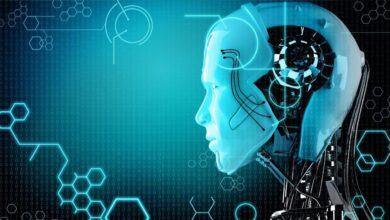Responsible AI: Building Trust In The Algorithmic Age

The rise of Artificial Intelligence (AI) represents a monumental leap for humanity, ushering in an era of unprecedented efficiency, groundbreaking scientific discovery, and global connectivity that promises to reshape every industry and personal life.
AI systems now guide critical decisions in fields ranging from medical diagnostics and financial lending to criminal justice and autonomous transportation, making their impact both profound and intensely personal.
This incredible power, however, demands an equally rigorous commitment to ethics and responsibility, ensuring that these powerful tools are developed and deployed in a manner that aligns with core human values, respects fundamental rights, and benefits all of society, not just a select few.
The core philosophical challenge lies in defining the moral framework for machines that learn from, and often replicate, the imperfect, biased data created by humans, raising complex questions about fairness, accountability, and the loss of human oversight.
The ethical dilemmas surrounding AI are not futuristic problems; they are immediate concerns that require proactive solutions, demanding that developers, policymakers, and end-users alike engage in a continuous, critical dialogue about the long-term societal consequences of these new cognitive technologies.
Establishing clear, enforceable ethical guidelines is the foundational step necessary to build the essential trust that will allow AI to truly flourish as a force for good rather than a source of unintended systemic harm.
The Core Ethical Dilemmas of Artificial Intelligence

The field of AI ethics focuses on the moral principles and governance frameworks necessary to guide the design and use of AI systems, aiming to mitigate their risks and maximize their societal benefits. Several key issues dominate this conversation.
1. Fairness and Algorithmic Bias
The most pervasive and urgent ethical issue is the risk of algorithmic bias, which occurs when AI systems produce systematically unfair or discriminatory outcomes.
A. Sources of Bias
- Historical Data Bias: AI models learn from the data they’re fed, and if this historical data reflects past or existing societal prejudices (e.g., in hiring or lending), the AI will replicate and even amplify these biases.
- Representation Bias: Training data often lacks sufficient representation for certain demographic groups (e.g., women or minorities), leading to inaccurate or poor performance when the AI interacts with those groups.
- Subjective Human Input: Bias can be introduced by the subjective decisions of the developers who label the training data or decide which variables the algorithm should prioritize.
B. Manifestations of Unfairness
- Discrimination in Finance: An AI lending model might unfairly deny loans to applicants from a certain neighborhood or demographic, not based on actual creditworthiness but on historical patterns in the biased training data.
- Inequity in Hiring: AI screening tools, trained on data from a company that historically favors a specific gender, could unfairly down-rank qualified resumes from candidates of the underrepresented gender.
- Bias in Law Enforcement: Predictive policing algorithms, if trained on data reflecting historically biased arrests, can disproportionately flag certain communities as “high-risk,” creating a harmful feedback loop.
2. Transparency and Explainability (XAI)
As AI models, particularly complex deep learning networks, grow in sophistication, their internal decision-making processes often become opaque, earning them the nickname “black boxes.”
A. Defining the Terms
- Transparency refers to the openness and clarity about how an AI system works, including its design, data usage, and limitations.
- Explainability (often called XAI) is the ability of the system to provide understandable reasons for its specific decisions and outputs in a way a human can grasp.
B. The Black Box Problem
- Erosion of Trust: Users and affected individuals struggle to trust an AI system whose critical decisions, such as a medical diagnosis or a criminal justice recommendation, cannot be justified or explained.
- Difficulty in Auditing: The lack of transparency makes it extremely difficult for developers or regulators to inspect the model, identify where biases entered the system, or correct errors.
- Legal and Ethical Requirement: In sensitive applications, providing an explanation is often a basic legal or ethical requirement, necessary for due process or informed consent.
3. Accountability and Liability
In the age of autonomous systems, determining who is responsible when an AI makes a mistake or causes harm becomes an increasingly complex legal and moral challenge.
A. The Chain of Responsibility
- The Developer: The team that designs and codes the algorithm is responsible for its initial safety and ethical design.
- The Integrator/Deployer: The organization that chooses to implement the AI system in a specific real-world context bears responsibility for its safe deployment and monitoring.
- The User/Operator: The human who ultimately interacts with and oversees the AI must be held accountable for its proper use within established parameters.
B. The Liability Quagmire
- Autonomous Vehicles: If an autonomous car causes an accident, is the manufacturer liable for the algorithm’s mistake, the owner for its operation, or the software provider for the code?
- Medical Errors: If an AI diagnostic tool makes an error that leads to a misdiagnosis, the ethical and legal liability must be clearly assigned, likely requiring a “human-in-the-loop” oversight model.
- Need for Governance: Clear legal frameworks and robust internal governance mechanisms, such as AI Ethics Committees, are necessary to establish clear lines of accountability before incidents occur.
4. Privacy and Data Governance
AI relies on vast quantities of data to function and learn, creating immense pressure on existing data privacy frameworks and user consent models.
A. The Data Hunger
- Mass Surveillance Risk: AI technologies, particularly facial recognition and behavioral analytics, pose a significant risk of large-scale, intrusive surveillance by both governments and corporations.
- Consent Challenges: Obtaining meaningful, informed consent from individuals for the complex and future-proof use of their data in evolving AI models is extremely difficult.
- Security Vulnerability: Centralizing massive, sensitive datasets for AI training creates a huge target for cyberattacks and data breaches.
B. Mitigation Strategies
- Privacy-by-Design: Ethical development requires integrating privacy protection measures directly into the system architecture from the very beginning, not as an afterthought.
- Differential Privacy: Techniques that introduce controlled “noise” or distortion to aggregated data, allowing AI to learn general patterns while preventing the identification of any single individual.
- Data Minimization: Developers should only collect and use the precise amount of data necessary to achieve the specific, stated goal of the AI system, no more.
Establishing Principles for Responsible AI Development
To meet these ethical challenges head-on, organizations, governments, and international bodies have begun to establish guiding principles for the development and deployment of Responsible AI (RAI). These principles serve as a moral compass for the entire AI lifecycle.
A. Human Oversight and Control
A. Human-Centric Design
AI systems must be designed to augment and assist human capabilities, not to diminish human autonomy or decision-making authority.
B. Human-in-the-Loop
Critical decisions should always have a designated human supervisor who retains the ultimate authority to intervene, override, and take responsibility for the AI’s action.
C. Respect for Human Rights
AI deployment must consistently uphold and adhere to internationally recognized human rights and democratic values.
B. Safety, Security, and Robustness
A. Proportionality and Do No Harm
The use of an AI system should be proportional to its legitimate aim and should carry rigorous risk assessments to prevent unintended negative consequences or physical harm.
B. System Resilience
AI systems must be designed to be robust and resilient against both external cyberattacks and internal data corruption that could compromise their accuracy or safety.
C. Continuous Monitoring
Post-deployment, AI systems require ongoing, active monitoring to detect and correct performance drift, emerging biases, and unexpected vulnerabilities in their live operational environment.
C. Sustainability and Environmental Responsibility
A. Energy Consumption
The training and operation of complex AI models, particularly Large Language Models (LLMs), require massive computational power, which consumes substantial energy.
B. Prioritizing Efficiency
Developers must prioritize sustainable practices, designing models and hardware that minimize energy demands and computational overhead whenever possible.
C. Alignment with ESG Goals
AI development should be explicitly assessed for its positive or negative impact on Environmental, Social, and Governance (ESG) principles, especially in the context of climate change mitigation.
Strategies for Mitigating AI Bias and Ensuring Fairness

Bias is not an optional bug; it’s an inherent feature of learning from real-world data, but robust strategies exist to detect and correct it throughout the AI lifecycle.
A. Pre-Processing Techniques (Data)
This stage focuses on cleaning and balancing the data before it ever touches the model.
A. Diverse Data Sourcing
Actively seek out and include representative data from all relevant demographic groups, ensuring no group is statistically underrepresented.
B. Re-sampling and Augmentation
Use techniques to balance the dataset by duplicating or synthesizing data points for underrepresented classes.
C. Bias Detection Tools
Employ specialized software to automatically scan and identify statistical biases and sensitive attributes within the raw training data.
B. In-Processing Techniques (Modeling)
This stage focuses on modifying the algorithm itself during the training phase.
A. Fairness Constraints
Incorporate mathematical constraints into the model’s objective function that explicitly penalize the model for producing disparate outcomes across protected groups.
B. Fair Representation Learning
Transform the input data into a new, unbiased feature space that is less likely to carry forward the original discriminatory signals.
C. Using Unbiased Proxies
Actively eliminate discriminatory variables (like race or gender) and be cautious of seemingly neutral variables (like zip code or specific purchasing habits) that might act as biased proxies.
C. Post-Processing Techniques (Outputs)
This stage involves adjusting the final output of the model to ensure fairness before a decision is finalized.
A. Threshold Adjustment
Instead of using a single confidence threshold for all groups, adjust the decision threshold for different demographic groups to ensure fairness metrics (like true positive rates) are equalized.
B. Re-ranking
Adjust the order of the model’s recommendations (e.g., in a search result or job applicant list) to ensure fairer representation.
C. Continuous Monitoring
Implement live systems to continuously track the model’s performance on various demographic slices after deployment, allowing for rapid intervention if bias emerges.
Fostering Transparency and Accountability in Practice
Making the “black box” visible is achieved through dedicated technical and governance measures that build user trust.
A. Technical Explainability (XAI)
A. Local Explanation Methods
Use tools like LIME or SHAP to determine which specific input features were most influential in generating a particular, individual output or decision.
B. Model Interpretability
Where possible, favor simpler, inherently understandable models (like decision trees) over complex neural networks when the application demands high levels of clarity.
C. Clear Documentation
Maintain comprehensive and detailed records of the model’s design choices, training data sources, testing results, and fairness metrics throughout its entire lifecycle.
B. Governance and Auditing
A. External Audits
Require periodic, independent audits of AI systems to verify their compliance with ethical guidelines, legal requirements, and fairness benchmarks.
B. Internal Ethics Boards
Establish clear internal governance bodies and ethics committees with diverse membership to review, approve, and oversee all AI development and deployment decisions.
C. Transparency Reports
Organizations should regularly publish public reports detailing the AI systems they use, their purpose, the data they rely on, and the specific safeguards in place to protect user interests.
C. Establishing Clear Accountability
A. Define Human Roles
Clearly designate the Human-in-the-Loop who has the final authority and liability for decisions made by an AI system.
B. Traceability
Ensure every decision made by an AI system is traceable back to its input data, model version, and the individual responsible for its deployment.
C. Redress Mechanisms
Create clear, accessible pathways for individuals to appeal an adverse decision made by an AI system and have their case reviewed by a human.
Conclusion: An Unavoidable Human Responsibility
The ethical challenges presented by AI are neither minor nor temporary concerns.
These issues of bias, transparency, and accountability demand immediate and sustained attention.
Responsible AI development is not a technical add-on; it is a core design philosophy.
Establishing human oversight is critical to ensuring technology serves human welfare.
We must actively audit data and algorithms to prevent the replication of societal prejudices.
The future of technology relies entirely on our ability to build and maintain public trust.
Ethical frameworks provide the necessary guardrails for AI’s incredible power.
Embracing these principles is the only way to realize AI’s full potential for good.



